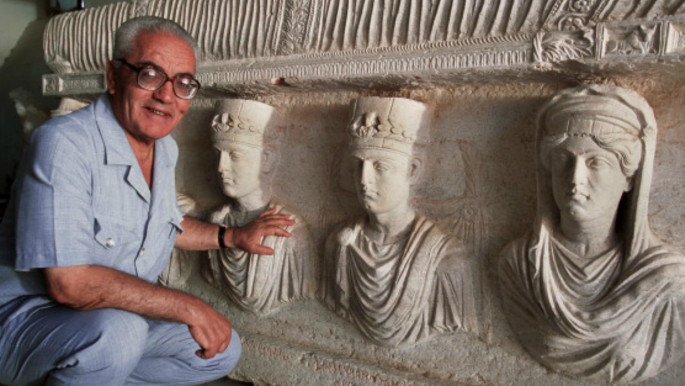Archaeologists assess damage on Palmyra as 'victory' boosts regime-propaganda
The Syrian regime army, back by allied militiamen and major Russian airpower, ousted IS-militants from Palmyra on Sunday following an intensive three-week offensive.
Syrian president Bashar al-Assad hailed the victory as "important" and posed as "fresh proof of the efficiency of the Syrian army and its allies in fighting terrorism."
Despite claims of a major withdrawal from Syria last week, Russian forces were heavily involved.
Russian warplanes carried out 40 combat sorties around Palmyra in the last 24 hours, striking 117 "terrorist targets" and killing 80 IS fighters, Moscow’s defence ministry confirmed on Sunday.
But activists have told The New Arab that the regime-led assault itself took little consideration of the famous archaeological ruins of Palmyra.
"The regime launched this offensive assuming everything on the ground has already been destroyed," spokesman for Homs Media Centre Mohammed al-Sibai said.
"In the last week along, 900 airstrikes were fired," Sibai told The New Arab, "while on Saturday 300 airstrikes were conducted along with a number of missile strikes and bombings."
 |
It's a blessing both for the site and the people who live nearby. There's no question about that, even if we know the city is now in the hands of another dictator. |
 |
Sibai pointed out that "military operations led by the Syrian regime have caused heavy damage to both the archaeological ruins and the civilian infrastructure of the city, as well as destruction in most of the surrounding areas."
Some, however, celebrated the recapture despite the city returning to Assad regime control.
"One can only rejoice at the ousting of IS, which is founded on extreme violence and the systematic destruction of ancient artefacts," historian Maurice Sartre told AFP.
"It's a blessing both for the site and the people who live nearby. There's no question about that, even if we know the city is now in the hands of another dictator," Sartre added.
Assessing the Damage
| A view of the Roman Theatre in the ancient city of Palmyra where the Islamic State staged executions |
Residential neighbourhoods in the adjacent modern town of Palmyra, where 70,000 people lived before the war, are reported to be deserted with widespread damage.
Local archaeologists visited the site of Palmyra's famous ruins on Monday to assess the damage wreaked during the year-long control by IS militants.
This is despite the already documented destruction of the famous Temple of Bel by IS militants in August 2015.
Syria's antiquities chief said the priceless artefacts had survived better than feared from a campaign of destruction UNESCO described as a "war crime".
"We were expecting the worst. But the landscape, in general, is in good shape," Maamoun Abdulkarim told AFP from Damascus.
"One mustn't forget that only around 15 to 20 percent of Palmyra had actually been excavated, and so there was an enormous amount yet to discover," Historian of the ancient world Maurice Sartre said.
"All the tombs we hadn't excavated and have now been totally pillaged are lost to science forever."
 |
All the tombs we hadn't excavated and have now been totally pillaged are lost to science forever. |  |
The ruins of Palmyra, some 215km northeast of Damascus, are an extensive series of public buildings, temples and other archaeological sites dating from the second century BC to the fourth century AD when Palmyra stood as capital city of the regional Palmyrene Empire.
As well as the now destroyed Temple of Bel, the ruins include the famous "Roman theatre of Palmyra" built in the second century CE and the "Great Colonnade," a 1.1 kilometre long central avenue flanked by columns built over the second and third centuries CE.
IS militants sparked wide-spread condemnation for their wanton destruction of artefacts in Palmyra's museum, along with the demolition of the Temple of Bal, after seizing control of the city in 2015.
The militants justified their destruction as the ruins were those of an "idolatrous" civilization.
Militants further used ruins, notably the Roman theatre, as sites of public executions which they subsequently broadcast on social media.
IS-militants also executed Palmyra's 82-year old former antiquities chief Khaled al-Asaad.
 |
| Khaled al-Asaad, the Director of Antiquities and Museum in Palmyra, was murdered by IS militants [Getty] |
Restoring ancient ruins
Meanwhile, Syrian antiquities chief said on Monday it will take five years to restore the ancient ruins of Palmyra, which were destroyed by Islamic State [IS] militant group under their control of the area.
"If we have UNESCO's approval, we will need five years to restore the structures damaged or destroyed by IS," Abdulkarim said.
"We have qualified staff, the knowledge and research. With UNESCO's approval we can start the work in a year's time," he added.
"Eighty percent of the ruins are in good shape," Abdulkarim said.
"My expert colleagues arrive today in Palmyra. I have asked them to assess the stones and the old city. They are taking pictures of the damage and documenting everything, and then the restoration can begin."
The Syrian regime army said the city would now serve as a base to "broaden operations" against IS, including in its stronghold of Raqa and Deir Ezzor further east.
At least 400 IS fighters were killed in the battle for Palmyra, the Syrian Observatory for Human Rights said.
On the government side, 188 troops and militiamen were killed.
"That's the heaviest losses that IS has sustained in a single battle since its creation" in 2013, the director of the Britain-based monitoring group, Rami Abdel Rahman, told AFP.
The ancient city, northeast of Damascus, drew some 150,000 tourists a year before Syria's civil war and is known to Syrians as the "Pearl of the Desert."
Syrian state television broadcast footage from inside Palmyra's famed museum, showing jagged pieces of sculptures on the ground and blanketed in dust.
Agencies contributed to this report.



